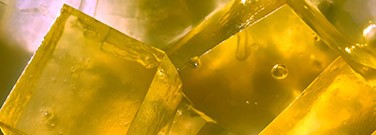Cool Science: Reusable Ice Cubes

By Christina P. Hooton
It doesn’t get any cooler than this: Researchers at the University of California, Davis, are developing reusable ice cubes. Made from a hydrogel similar to Jell-O, these gel cubes can be reused roughly 10 to 12 times and are compostable. If proven effective, they could become an eco-friendly alternative to ice packs and lead to other food innovations.
Ice, Ice Baby
True to their name, hydrogel ice cubes contain gelatin, but they are mostly composed of water — 90 percent to be exact. Unlike regular ice cubes, which melt when exposed to heat, gel ice cubes trap the water in their structure, so they can be thawed and refrozen many times without losing their shape. Moreover, when an ice cube melts, the liquid is released and can carry bacteria to other foods, causing cross-contamination. Hence, gel ice cubes present a potentially cleaner alternative.
When compared with the cooling power of regular ice cubes, gel cubes come close. Researchers tested their effectiveness by packing foam-insulated containers with food samples and either gel or ice cubes. After almost an hour, ice-cooled samples reached 38°F, while gel-cooled samples reached 40°F.
Strength was another factor put to the test. When researchers increased the gelatin content, the cubes became stronger. However, higher gelatin percentages showed lower cooling efficiency. Gel cubes containing 10 percent gelatin had the best balance of cooling power and strength.
Skating on Thin Ice
With all their promise, gel ice cubes still present some challenges. They are more expensive than regular ice cubes, but reusability can help justify the price. The research team is already working to enhance stability by improving the connections between proteins in the gel’s sponge structure.
Additionally, the gelatin might attract microbes. Although the cubes don’t melt, they could still come in contact with other food and absorb bacteria. The gel cubes can be cleaned using bleach, but the gel might absorb the bleach and release it onto food, introducing safety concerns.
Another issue is that the gelatin itself is an animal product vegetarians would likely avoid.
Although there are some hurdles to overcome before gel ice cubes become mainstream, the food industry could use this technology for other applications, such as freezing food. When food is frozen, its cells are destroyed by large ice crystals, causing changes to the taste and texture. The polymers in hydrogels could help control the size of these ice crystals, better preserving the quality of the food.
Gel ice cubes may be on ice for now, but the potential of hydrogel technology for food preservation is just starting to heat up.
Discussion Questions
- If proven viable, how could gel ice cubes benefit the environment?
- What applications besides food preservation might benefit from gel ice cubes?